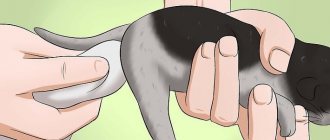What is the normal temperature for cats?
The normal body temperature for a newborn (this is considered a kitten up to 10-15 days old) is considered to be 35-36 °C. For an adult, this figure is slightly higher and approaches 38-38.5 °C. These standards are universal and suitable for animals of any breed.
A sick animal always needs veterinary care
For your information! A slight increase in this indicator is normal for a cat. Most often, this phenomenon can be observed in the evening hours, after prolonged physical activity, as well as during pregnancy of the animal.
An increase in temperature above 40 °C poses a threat to the health and life of the animal.
Is it possible to find out the temperature without a thermometer?
Determining a cat's temperature without a thermometer is quite difficult - signs that may indicate an increase in temperature (hot nose, prominent third eyelid, decreased appetite and physical activity) are indirect and do not provide an accurate picture of the disease. Based on these signs, one can only suspect a deterioration in the pet’s condition, and the indicators can only be found out with the help of a thermometer.
To find out your cat's temperature, you can take a regular or electronic thermometer.
How to determine a cat's temperature without a thermometer
How to trim a cat's claws: options at home
Determining the temperature of an animal without using a thermometer (for example, by touching the animal) is quite difficult, since the normal temperature values for humans and cats differ significantly. However, changes in the animal's behavior, as well as some symptoms, should alert the owner.
The main signs that indicate that an animal needs veterinary care include:
- dry and hot cat nose (the exception is hot weather; a similar symptom can also be observed in older cats due to changes in the functioning of the endocrine glands);
- appetite disorders;
- fur and ears that are hot to the touch;
- increased heart rate and breathing;
- inactivity;
- unreasonable fear of people;
- chills;
- dilated pupils;
- pallor of the mucous membranes;
- urge to vomit;
- strong thirst;
- discharge from the eyes, ears, nose.
A sick animal tries to minimize contact with others; most often it can be found huddled in the darkest corner, unusually quiet and inactive. It should be taken into account that an increase and decrease in temperature is also accompanied by different symptoms and can be caused by different reasons.
A change in an animal’s habitual behavior most often indicates a developing disease.
An increase in temperature can be caused by:
- reaction to certain medications;
- poisoning;
- past infectious diseases;
- diseases of the endocrine system;
- impaired metabolism;
- oncological diseases;
- worms.
If the temperature rises seriously, you should contact your veterinarian immediately. The specialist needs to be informed about the symptoms accompanying the disease and what the temperature has been recently.
A decrease in the indicator may be caused by:
- previous anesthesia;
- state of shock;
- injuries;
- hypothermia;
- diseases of the nervous and cardiovascular systems;
- drugs that lower blood pressure.
Important! To provide first aid to an animal at a low temperature, it should be given water, wrapped in a blanket and a heating pad placed next to it.
First aid for fever
It is important to remember that lowering the temperature at home is not recommended.
Remember! Giving antipyretics intended for humans is prohibited. This can cause complications and cause great harm to the pet.
Before going to the doctor, you can do the following:
- calm the cat down by placing it on your lap and give it a light massage;
- give clean, fresh water to drink;
- ventilate and cool the room in which the cat is located, providing a flow of fresh air into the room.
A rise in temperature is not always dangerous. This is just a signal from the body, indicating problems and inflammatory processes. Only after a comprehensive examination can the doctor prescribe an adequate treatment regimen. In most cases, specialists prescribe a course of antibiotic therapy. If there is no effect, the treatment regimen is changed.
It is important to note that hypothermia (a decrease in the animal’s body parameters) also signals problems and pathologies in the body. The causes of a sharp decrease in body temperature may be internal blood loss or hypothermia. In some cases, the cause of low body temperature is disruption of the kidneys or endocrine system.
Useful materials:
- The cat is sneezing, what should I do? Finding out the cause of cat sneezing In 99% of cases, sneezing that does not stop for a long time is associated with...
- A cat licks his eggs after castration. Is it possible to lick a woundDespite the fact that the saliva of our little brothers contains enzymes and...
- Can a neutered cat Why does a neutered cat show interest in a cat? What to do if a cat wants a cat after castration?...
- A cat in your arms How to accustom a cat to being held in your arms You can try to accustom a cat to physical contact, but to do this...
Measurement Rules
It is best if the temperature is measured while the animal is sleeping. If this is not possible, you need to adhere to the following recommendations.
How to give an injection to a cat at the withers: intramuscularly and at home
If possible, you need to wrap the cat in a blanket or a warm blanket so that the paws are fixed and the head and back of the body are free.
To calm the animal, you can scratch it a little behind the ear before the procedure. You need to talk to the animal calmly so that it does not perceive the procedure as a punishment.
It must be taken into account that the cat will resist inserting the thermometer inside even if it seems completely weakened and lifeless. However, these behavioral reactions will be observed only during the first procedure; subsequent ones, as a rule, are calmer.
To obtain a more reliable result, you can determine the animal’s body temperature in different ways (for example, measure it in one way and check it with another). If all the rules are followed and the technique is correct (for example, when inserting a rectal and ear thermometer), the two readings should match.
Note! If you cannot fix the animal yourself, you can contact a veterinary clinic for help and conduct an examination there.
Types of thermometers and their features
Before touching on the question of how to measure the temperature of a cat, you need to consider the most common types of thermometers.
How to give a cat an enema at home
The most accessible and familiar to most breeders is a regular mercury thermometer. However, measuring body temperature with it is not safe. The duration of the procedure (from 5 minutes) makes it even more unpleasant and painful for the pet, and sudden movements and attempts to resist can lead to damage to the integrity of the thermometer.
Important! If the thermometer breaks during the procedure, the mercury must be collected using a copper plate. It is highly undesirable to use paper and rags. If residues of a toxic substance enter the animal's rectum, you should immediately contact a veterinarian.
An electronic thermometer is more convenient to use; it gives results within 1-2 minutes. after the start of the procedure, and also has high accuracy. Many of them are also equipped with a special sound sensor.
Digital Thermometer
A rectal thermometer is considered the most acceptable because it does not need to be inserted too deeply into the animal’s body, it is equipped with a special sound signal, and is also small in size.
An infrared thermometer can also be used to measure an animal's body temperature. One of its main advantages is that the device does not come into direct contact with the pet’s body and can be located at a distance of 5 to 15 cm from it. However, when working with such a thermometer, you need to remember that in the first few minutes it can react to the temperature not of the animal’s body, but of the environment, which is why you need to wait a little for more accurate indicators. Also, if possible, you should take a second measurement by placing the device behind the cat’s ear.
Note! Infrared thermometers are the most expensive.
Rectal temperature measurement
How to measure a cat's temperature rectally? This is the most reliable way to measure your pet's body temperature.
The thermometer is thoroughly washed with soap and water, then generously lubricated with Vaseline or greasy cream. Then the device is inserted into the animal’s rectum with slow, careful rotational movements no deeper than 1 cm. An important condition: the thermometer must be slightly tilted so that its tip touches the walls of the rectum.
Rectal method of measuring temperature
When measuring the temperature, it is best to talk to the animal calmly and also avoid sudden movements that could injure it.
The advantages of the procedure are the ability to find out the exact indicator, no need to spend a lot of time on the procedure.
Disadvantages - this procedure is very unpleasant and painful for the animal, so the owner is required to carefully prepare for the procedure and take into account all its nuances.
Before measuring the temperature in this way, it is advisable to trim the animal’s claws and also secure it well. If possible, it should stand or lie on its side. It is also desirable that two people participate in this and be able to hold the cat by the paws, scruff and head. It is very undesirable for a cat to curl up in a ball or press its tail to its body.
After the owner has managed to measure the cat’s temperature, the thermometer must be wiped with alcohol and thoroughly disinfected, and the animal must be petted and tasty fed as encouragement.
If, when removing the thermometer, there are remains of black tarry feces or blood on it, you should immediately contact a veterinarian. These symptoms may indicate serious complications of the disease.
Important! After disinfecting the thermometer, it is also important to thoroughly rinse the sink so as not to spread the infection throughout the apartment.
Measuring body temperature in the ear canal
Since the rectal method is very inconvenient and unpleasant for the animal, more and more owners are wondering if there is an alternative. In fact, this can be done in other ways as well. Below we will discuss how to measure the temperature of a cat using an ear thermometer.
Measuring temperature with an ear thermometer is a less painful way for cats
Practice shows that pets react quite calmly to inserting a thermometer into the ear canal, and there is no need for fixation. The procedure will be especially easy for those cats that are accustomed to their owners scratching or rubbing the inside of their ears. However, it is best to take the help of another person here too. In this case, it is best to hold the cat by the scruff (the area of skin between the neck and shoulder blades). This will allow the animal to keep its head still and not interfere with the temperature measurement. It is also interesting that this position has a calming effect on many animals.
Ear thermometers are much more convenient than rectal thermometers, which is why there is no need to be afraid to insert them deep enough. The thermometer itself should be in a horizontal position. The temperature is measured in the area of the eardrum, which is sensitive to the blood circulating in the brain area. You need to keep the thermometer in the ear until the beep sounds. The obtained result is compared with the norm.
Note! When measuring temperature in this way, you must always remember that an ear thermometer has a wider range of permissible temperature values (from 38 °C to 39.5 °C). However, as in other cases, a temperature drop below 37 °C and above 40 °C is a reason to immediately consult a doctor.
Despite the fact that at first glance this method may seem more convenient and painless, it is also not without its drawbacks. It is much more difficult to insert such a thermometer into the auricle, which is why the temperature determined in this way cannot be considered completely reliable. Another disadvantage of the device is its high cost.
When to measure a domestic cat's temperature correctly
In extreme cases, a mercury thermometer is also suitable.
But sometimes it becomes necessary to measure the cat’s temperature at home. The reason for this may be the unusual behavior of your pet. If the temperature has risen, the cat is likely to:
- He will try to hide in a secluded place and lie motionless, refusing to eat. Nature tells her this way of fighting the disease. Fasting and saving energy help direct internal energy to fight the disease.
- A sick cat's nose will be dry and hot.. But remember: if you touch the nose of an animal that has just woken up, it may also turn out to be dry and warm, this is normal.
If your cat's nose is dry, it most likely has a fever. How to know if the temperature is elevated here.
- closes her eyes every now and then , and her third eyelid is noticeable.
- Another characteristic symptom is chills . From the outside it may seem that the animal is cold, and this makes it tremble. In fact, it's a fever.
Case from practice
Taking a kitten's temperature
That’s how we realized that our three-month-old kitten was sick. He was shaking violently. We immediately went to the vet. And the first thing the doctor did, putting Muska on an iron table, was to put a thermometer under her tail. The temperature turned out to be very high.
“It’s good that you didn’t hesitate,” said the doctor, “Cats tolerate such heat very poorly.” There could have been a fatal outcome.
Result evaluation
When measuring temperature with a mercury thermometer, you need to pay attention to the scale. An electronic or infrared analogue displays the result directly on the display.
Important! If, according to the results of measurements, the animal’s body temperature is normal, but it still shows signs of illness or poor health, you should immediately contact a veterinarian.
Which of the above methods to choose is up to each breeder to decide for himself. In any case, it should not cause injury to the animal, so you should re-read the article again to know exactly how to correctly measure this important body indicator.
Causes of elevated temperature, what to do?
The culprits of fever can be:
- infections;
- allergies;
- side effects from pharmaceutical drugs;
- injuries.
Simple ways to reduce your temperature:
- Wrap the sick cat in a wet towel, paying special attention to the inguinal folds and belly. The effect will become noticeable if the sick mustache is able to endure the inconvenience for 25-30 minutes.
- Experienced owners mix crushed ascorbic acid into cottage cheese and yogurt.
- To strengthen the immune system, give your cat echinacea tincture. It is dissolved in a small amount of boiled water. Dosage – 1 drop per 1 kg of animal weight twice a day.
- Provide your pet with fresh air, but make sure there are no drafts.
- Buy homeopathic arnica at the pharmacy and give it to the animal in the doses recommended by the veterinarian.
Don't forget that meowing pets are masters at masking their illnesses. It is important to be attentive to them, to promptly identify and eliminate emerging pathologies in the body. Hello to your furry friends!











